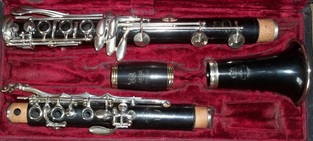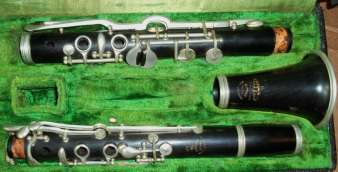Why Vintage Clarinets?

1940's Penzel Mueller Artist full Boehm
In this era of high prices and shoddy 3rd world labor, why not try a vintage clarinet or saxophone restored by the Vintage Clarinet Doctor? You'll save money, get a quality instrument, conserve finite resources, preserve craftsmanship, and support goods and services from the USA!
Years ago I began to realize that there were other clarinets out there than just the 'Big 3' (Buffet, Selmer and Leblanc) for serious players, and Yamaha plastic for everyone else! Ebay, private sales, estate sales and auctions introduced me to a whole new world of antique and vintage clarinets; some makers are still in business, some defunct, some absorbed by conglomerates. Many can be acquired in original condition for the price of dinner for 2 and a movie, and need only the repairman's time and skill to restore them from potential lamp or wall-hanger into a working instrument, ready to make music now and for years to come. Remember -
"Not Everyone Needs an R-13"
Years ago I began to realize that there were other clarinets out there than just the 'Big 3' (Buffet, Selmer and Leblanc) for serious players, and Yamaha plastic for everyone else! Ebay, private sales, estate sales and auctions introduced me to a whole new world of antique and vintage clarinets; some makers are still in business, some defunct, some absorbed by conglomerates. Many can be acquired in original condition for the price of dinner for 2 and a movie, and need only the repairman's time and skill to restore them from potential lamp or wall-hanger into a working instrument, ready to make music now and for years to come. Remember -
"Not Everyone Needs an R-13"
A Little History

1920's Kohlert Albert System
The 1870's - 1920's offer a cornucopia of simple system, Albert system, and early Boehm clarinets in a variety of keys to suit the needs of performers of period music, early Jazz, and ethnic Folk styles. Collectors enjoy them for craftsmanship, rarity, and a tactile link with the past. Teachers and schools use them for performance and education.
The 1920's - 1960's were the heyday of the modern clarinet, and provide a wealth of instruments in a variety of materials, bore sizes, and tonal and ergonomic options to suit every style of music, level of ability, and depth of pocketbook. Some desirable brands may cost a bit more, but most are still less than the going rate for a new plastic student clarinet!
After the mid 1960's, things started to get ugly. Many companies were bought out by bigger rivals with an eye for a bargain, older pro instrument lines became student lines (Buescher's Aristocrat, for example) and more and more instruments were being made overseas with the cheapest possible materials and assembly procedures. Ironically, prices for these instruments continue to rise, even as quality declines....
The 1920's - 1960's were the heyday of the modern clarinet, and provide a wealth of instruments in a variety of materials, bore sizes, and tonal and ergonomic options to suit every style of music, level of ability, and depth of pocketbook. Some desirable brands may cost a bit more, but most are still less than the going rate for a new plastic student clarinet!
After the mid 1960's, things started to get ugly. Many companies were bought out by bigger rivals with an eye for a bargain, older pro instrument lines became student lines (Buescher's Aristocrat, for example) and more and more instruments were being made overseas with the cheapest possible materials and assembly procedures. Ironically, prices for these instruments continue to rise, even as quality declines....